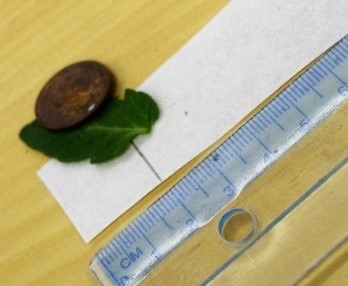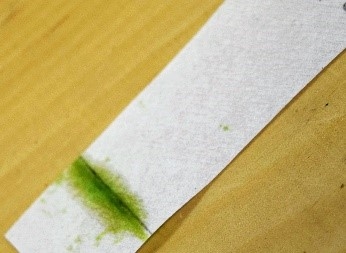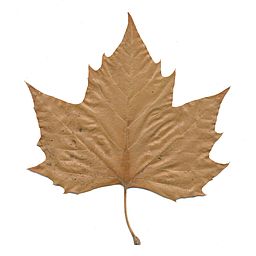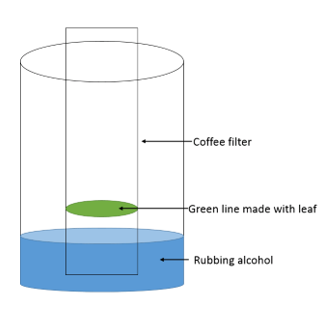Why do leaves change colour in the fall?
How does this align with my curriculum?
How do the green leaves of summer change to vibrant colours in fall? Explore plant pigments in this chromatography activity.
What You Need
- Fresh, green tree leaf (maple tree leaves works well)
- Strip of coffee filter paper (approximately 3-4cm wide and 10–15 cm long)
- Larger, thick coin
- Rubbing alcohol (isopropyl alcohol) available at most pharmacies
- Flat container at least 5 cm deep
- Table cloth or newspaper (for the mess)
Safety First!
Wear safety goggles when working with isopropyl alcohol and work in a well-ventilated space. Make sure to wash your hands with soap and water after the experiment.
What to Do
- Cover the table with a table cloth, or some other protector (newspaper).
- Place the strip of coffee filter paper on the table, with one of the small edges closest to you.
- Put the leaf over the filter paper at the end nearest you, 2 cm from the edge of the paper.
- Using the edge of the coin, roll it across the leaf from one side to the other on the filter paper. Aim to make the line 2 cm from the end of the paper. Let the pigment dry. Repeat 2-3 times on the same spot. Make sure the pigment is completely dry before beginning the next step.
- Pour about 2 cm of rubbing alcohol into the flat container.
- Carefully place the very edge of the filter paper closest to the green line into the alcohol. Do not allow the green line to touch the alcohol. Rest of top of the paper on the rim of the container. (See the diagram)
- Wait 30-60 minutes until the alcohol has travelled to the top of the filter paper.
- Remove the paper from the alcohol, let dry and examine. What do you see? What happened to the green line? How many colours do you see?


Discovery
In the fall, the leaves on trees change colour. These colours range from yellow to a dark, rich red-orange. The colours depend on the time of year, and on the species of tree you are looking at. In the spring and summer, the leaves are green because of the presence of a pigment called chlorophyll. All of the plant pigments that create the other colours that appear in the fall are actually present all of the time. However, there is so much chlorophyll that the green colour masks all of these other colours. In the fall, there is less sun and water for the trees to perform photosynthesis and make nutrients for themselves. As a result, the green chlorophyll pigment breaks down first, allowing the colours of the other pigments to be seen.
The process you performed on the fresh leaf, called chromatography, will separate out the chemicals, or plant pigments, that make all of these different colours. What you will see is the spectrum of colours that that particular leaf would have changed to in the fall.
The pigments in plants perform different important functions. Chlorophyll and carotenoids (red, orange or yellow pigments) are involved in the process of photosynthesis, which makes food energy for growth. Carotenoids also help protect a plant from light damage. Pigments called flavonoids are responsible for the bright colours that attract pollinators to flowers so that the plant can reproduce to make fruit and seeds.
Colourful plants are not only nice to look at! When we eat colourful fruits and vegetables we can benefit from the antioxidant properties of plant pigments, which help protect our cells and even reduce the risk of certain cancers.
- Try the chromatography process with a variety of leaves - even spinach!
- If the trees have already started changing colours, perform chromatography on both a red leaf and a green leaf. Are the results different?
- Learn more about Plant Pigments in this backgrounder from Tomatosphere™
For more information on this topic check out these Let's Talk Science resources:
- Plant Functions (Backgrounders) - Learn about the important plant functions of photosynthesis, respiration and transpiration and meet Dr. Smith, a professor of Plant Science at McGill University in Montreal.
- Plant Cell Structures and Functions (Backgrounders) - Learn about the many different structures that make up plant cells as well as what differentiates plant cells from animal cells.
What’s happening?
In the fall, the leaves on trees change colour. These colours range from yellow to a dark, rich red-orange. The colours depend on the time of year, and on the species of tree you are looking at. In the spring and summer, the leaves are green because of the presence of a pigment called chlorophyll. All of the plant pigments that create the other colours that appear in the fall are actually present all of the time. However, there is so much chlorophyll that the green colour masks all of these other colours. In the fall, there is less sun and water for the trees to perform photosynthesis and make nutrients for themselves. As a result, the green chlorophyll pigment breaks down first, allowing the colours of the other pigments to be seen.
The process you performed on the fresh leaf, called chromatography, will separate out the chemicals, or plant pigments, that make all of these different colours. What you will see is the spectrum of colours that that particular leaf would have changed to in the fall.
Why does it matter?
The pigments in plants perform different important functions. Chlorophyll and carotenoids (red, orange or yellow pigments) are involved in the process of photosynthesis, which makes food energy for growth. Carotenoids also help protect a plant from light damage. Pigments called flavonoids are responsible for the bright colours that attract pollinators to flowers so that the plant can reproduce to make fruit and seeds.
Colourful plants are not only nice to look at! When we eat colourful fruits and vegetables we can benefit from the antioxidant properties of plant pigments, which help protect our cells and even reduce the risk of certain cancers.
Investigate further
- Try the chromatography process with a variety of leaves - even spinach!
- If the trees have already started changing colours, perform chromatography on both a red leaf and a green leaf. Are the results different?
- Learn more about Plant Pigments in this backgrounder from Tomatosphere™
For more information on this topic check out these Let's Talk Science resources:
- Plant Functions (Backgrounders) - Learn about the important plant functions of photosynthesis, respiration and transpiration and meet Dr. Smith, a professor of Plant Science at McGill University in Montreal.
- Plant Cell Structures and Functions (Backgrounders) - Learn about the many different structures that make up plant cells as well as what differentiates plant cells from animal cells.

